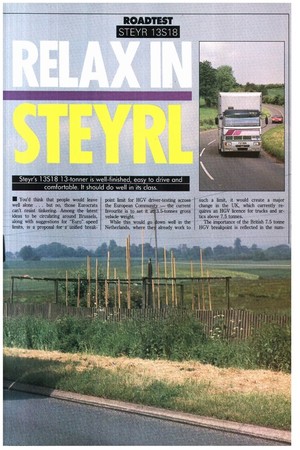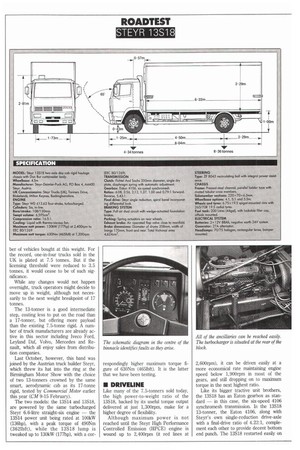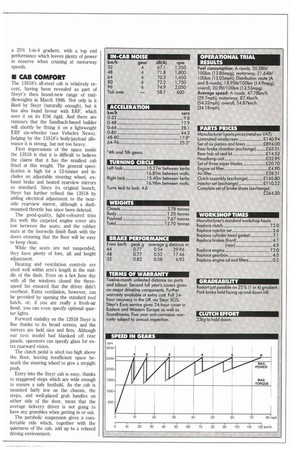iii You'd think that people would leave well alone .
Page 61

Page 62

Page 63

If you've noticed an error in this article please click here to report it so we can fix it.
. but no, those Eurocrats can't resist tinkering. Among the latest ideas to be circulating around Brussels, along with suggestions for "Euro" speed limits, is a proposal for a unified break point limit for HGV driver-testing across the European Community — the current favourite is to set it at13.5-tonnes gross vehicle weight.
While this would go down well in the Netherlands, where they already work to such a limit, it would create a major change in the UK, which currently requires an HGV licence for trucks and artics above 7.5 tonnes.
The importance of the British 7.5 tonne HGV breakpoint is reflected in the num ber of vehicles bought at this weight. For the record, one-in-four trucks sold in the UK is plated at 7.5 tonnes. But if the licensing threshold were reduced to 3.5 tonnes, it would cease to be of such significance.
While any changes would not happen overnight, truck operators might decide to move up in weight, although not necessarily to the next weight breakpoint of 17 tonnes.
The 13-tonner is a good intermediate step, costing less to put on the road than a 17-tonner, but offering more payload than the existing 7.5-tonne rigid. A number of truck manufacturers are already active in this sector including lveco Ford, Leyland Daf, Volvo, Mercedes and Renault, which all enjoy sales from distribution companies.
Last October, however, this band was joined by the Austrian truck builder Steyr, which threw its hat into the ring at the Birmingham Motor Show with the choice of two 13-tonners crowned by the same smart, aerodynamic cab as its 17-tonne rigid, tested by Commercial Motor earlier this year (CM 9-15 February).
The two models: the 13S14 and 13S18, are powered by the Same turbocharged Steyr 6.6-litre straight-six engine — the 13S14 power unit being rated at 100kW (136hp), with a peak torque of 490Nm (3621bft), while the 13S18 lump is tweaked up to 130kW (177hp), with a cor
respondingly higher maximum torque figure of 630Nm (465Ibft). It is the latter that we have been testing.
• DRIVELINE
Like many of the 7.5-tonners sold today, the high power-to-weight ratio of the 13518, backed by its useful torque output delivered at just 1,300rpm, make for a higher degree of flexibility.
Although maximum power is not reached until the Steyr High Performance Controlled Emission (HPCE) engine is wound up to 2,400rpm (it red lines at 2,600rpm), it can be driven easily at a more economical rate maintaining engine speed below 1,900rpm in most of the gears, and still dropping on to maximum torque in the next highest ratio.
Like its bigger tractive unit brothers, the 13S18 has an Eaton gearbox as standard — in this case, the six-speed 4106 synchromesh transmission. In the 13S18 13-tonner, the Eaton 4106, along with Steyr's own single-reduction drive-axle with a final-drive ratio of 4.22:1, complement each other to provide decent bottom end punch. The 13S18 restarted easily on a 25% 1-in-4 gradient, with a top end performance which leaves plenty of power in reserve when cruising at motorway speeds.
• CAB COMFORT
The 13S18's all-steel cab is relatively recent, having been revealed as part of Steyr's then brand-new range of middleweights in March 1986. Not only is it liked by Steyr (naturally enough), but it has also found favour with ERF, which uses it on its ES6 rigid. And there are rumours that the Sandbach-based builder will shortly be fitting it on a lightweight ERF six-wheeler (see Vehicles News). Judging by the 13818's body/payload allowance it is strong, but not too heavy.
First impressions of the space inside the 13S18 is that it is difficult to believe the claims that it has the smallest cab fitted at this weight. The general specification is high for a 13-tonner and includes an adjustable steering wheel, exhaust brake and heated rearview mirrors as standard. Since its original launch, Steyr has further refined the 13S18 by adding electrical adjustment to the nearside rearview mirror, although a dashmounted throttle has since been deleted.
The good-quality, light-coloured trim fits well; the carpeted engine cover sits low between the seats; and the rubber mats at the footwells finish flush with the doors ensuring that the floor will be easy to keep clean.
While the seats are not suspended, they have plenty of fore, aft and height adjustment.
Heating and ventilation controls are sited well within arm's length in the middle of the dash. Even on a hot June day with all the windows closed the threespeed fan ensured that the driver didn't overheat. Extra ventilation, however, can be provided by opening the standard roof hatch, or, if you are really a fresh-air fiend, you can even specify optional quarter lights.
Forward visibility on the 13S18 Steyr is fine thanks to its broad screen, and the mirrors are held nice and firm. Although our test model had blanked off rear panels, operators can specify glass for extra rearward vision.
The clutch pedal is sited too high above the floor, leaving insufficient space beneath the steering wheel to give a straight push.
Entry into the Steyr cab is easy, thanks to staggered steps which are wide enough to ensure a safe foothold. As the cab is mounted fairly low on the chassis, the steps, and well-placed grab handles on either side of the door, mean that the average delivery driver is not going to have any grumbles when getting in or out.
The parabolic suspension gives a comfortable ride which, together with the quietness of the cab, add up to a relaxed driving environment.




















































































































































